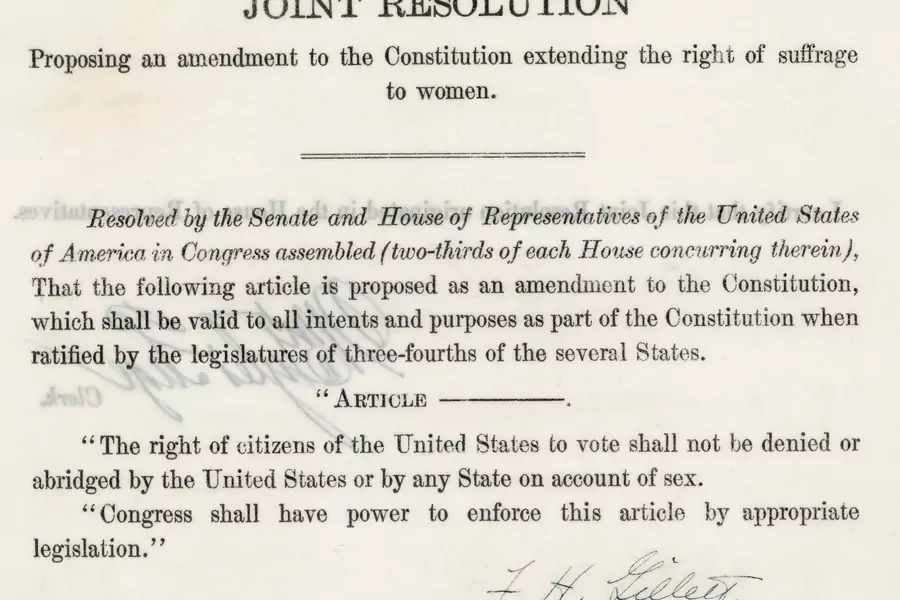TWE Remembers: The Ratification of the Nineteenth Amendment

This blog post was authored by Anna Shortridge, research associate for U.S. foreign policy at the Council on Foreign Relations.
One hundred years ago today, U.S. Secretary of State Bainbridge Colby certified that the Nineteenth Amendment was ratified as part of the Constitution. More than seventy years after the Seneca Falls Convention, women had finally won the right to vote in all elections. Centennials of pathbreaking constitutional amendments are worth noting, so my colleague Anna Shortridge wrote up a short history of the amendment’s passage and assembled a list of websites for learning about the suffrage movement and the passage of the amendment that ended the disenfranchisement of half the country’s citizens.
More on:
The Nineteenth Amendment runs just twenty-seven words: “The rights of citizens of the United States to vote shall not be denied or abridged by the United States or by any State on account of sex.” But it took decades of letter writing, protests and marches, and even hunger strikes and physical violence to make those words a constitutional reality. Some states didn’t wait for the federal government. By 1920, twenty-seven states had already granted women partial or full voting rights. Wyoming holds the distinction of being the first state or territory to give women voting rights. Wyoming also holds the distinction of being the first state to send a woman to Congress—it elected Jeannette Rankin to the U.S. House four years before the Nineteenth Amendment was ratified—and the first state to elect a woman as governor—it elected Nellie Ross to the State House in 1924.
Congress caught up to the majority of states when it passed the Nineteenth Amendment on June 4, 1919, and sent it to the states for ratification. The Union had forty-eight states at the time, so ratification required the approval of thirty-six states. Wisconsin was the first state to say yes, giving its approval on June 10, just hours before Illinois and Michigan did likewise. By July 1920, another thirty-two states had passed the amendment. Eyes then turned to the Tennessee state legislature. Many southern states opposed giving women the right to vote, and the Volunteer State looked to be no different. Although the Tennessee Senate voted overwhelmingly in favor of ratification, the Tennessee House was deadlocked. Or at least it was up until the moment that twenty-four-year-old state legislator Harry Burn, whose mother sent him a note urging support for the amendment, changed his vote. Eight days later, on August 26, 1920, the Nineteenth Amendment officially became part of the U.S. Constitution with the secretary of state’s certification of the vote.
So the 1920 presidential election was the first in which both men and women had the formal right to vote. But for many women of color, and especially those living in the South, the Nineteenth Amendment represented only an abstract victory. It would not be until the passage of the Indian Citizenship Act in 1924 that Native Americans were recognized as U.S. citizens. Immigrants from Asia didn’t fully get the right to become citizens until 1952. And most notoriously, a variety of state laws effectively disenfranchised Black Americans until the passage of the Voting Rights Act of 1965. Even today obstacles hinder the ability of many women to vote.
To learn more about the history of the Nineteenth Amendment, check out these seven terrific online resources:
And Nothing Less: The Untold Stories of Women’s Fight for the Vote. Hosted by Rosario Dawson and Retta, this seven-part podcast series discusses “the stories we didn’t learn in our history books” about women’s suffrage and the women behind the movement.
More on:
Beyond the Vote: 100 Years of Women’s Leadership. The Christian Science Monitor produced a special series of articles commemorating the centennial anniversary of the Nineteenth Amendment, exploring the history of the suffrage movement, and telling the stories of women around the world fighting for equality today.
Five You Should Know: African American Suffragists. Black women pioneered for the right to vote despite the fact that they, along with other women of color, were barred from participating in the suffrage movement alongside white suffragists and were frequently denied the right to vote even following the passage of the Nineteenth Amendment. The National Museum of African American History and Culture tells the stories of five prominent Black suffragists.
The National Women’s History Museum’s Online Exhibits. This collection of online exhibits covers a range of topics, including the history of women in STEM, Black women’s involvement in the civil rights movement, and women in Congress.
Rightfully Hers: American Women and the Vote. The National Archives is commemorating the centennial of the Nineteenth Amendment with an online exhibit featuring primary documents from the suffrage movement and some free online streaming events over the next several days.
Suffrage at 100. The New York Times plumbed its archive for articles on how women got the right to vote and what it meant when they did. The stories include those of the women of color who were at the forefront of suffrage movement, the impact of the 1918 flu on the movement, and the descendants of suffragists who followed in their ancestor’s footprints. The Times also created a "Votes for Women" board game to let you have some fun and learn about the road to ratification at the same time.
Votes for Women: A Portrait of Persistence. The National Portrait Gallery explores the suffrage movement both chronologically and thematically with photos, paintings, lithographs, banners, embroidery, and much, much more.
Finally, if you are interested in learning more about women’s involvement in, and impact on foreign policy, check out the work being done by my colleagues in CFR’s Women and Foreign Policy program. Rachel Vogelstein, the program’s director, recently appeared on The President’s Inbox to discuss the significance of the Nineteenth Amendment and the impact of women gaining political power.
 Online Store
Online Store